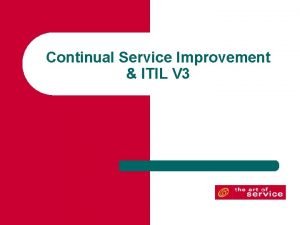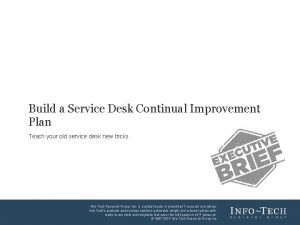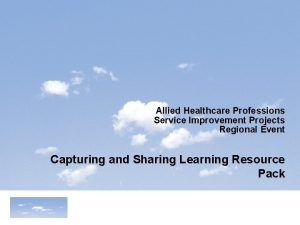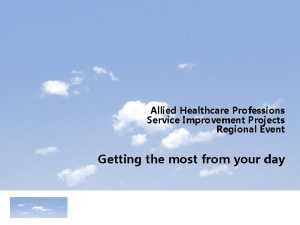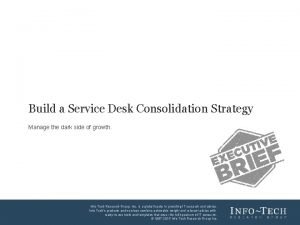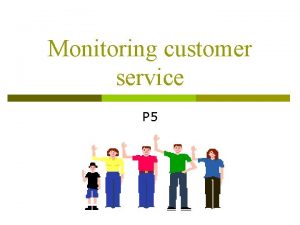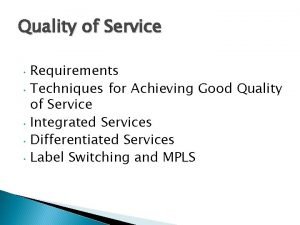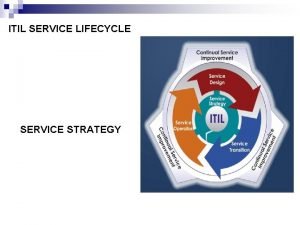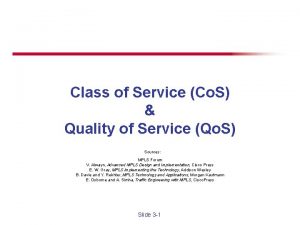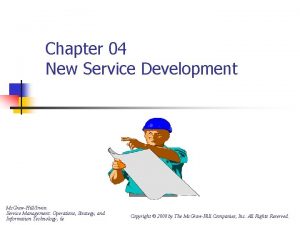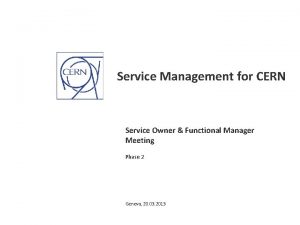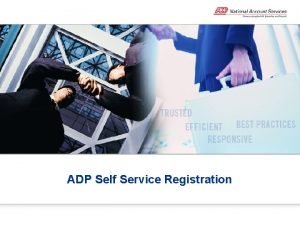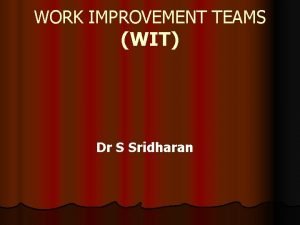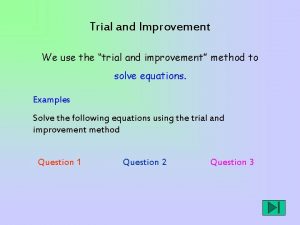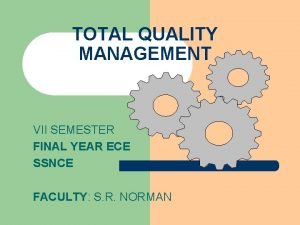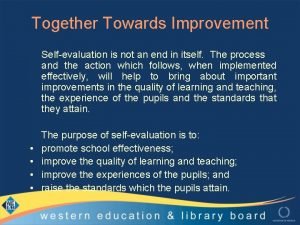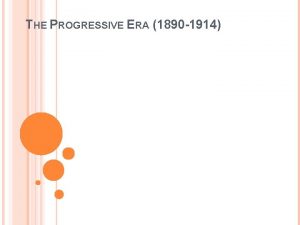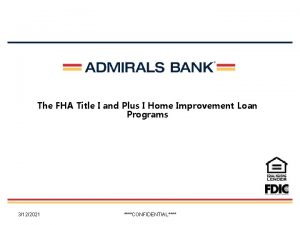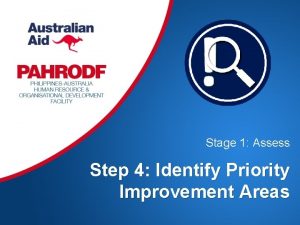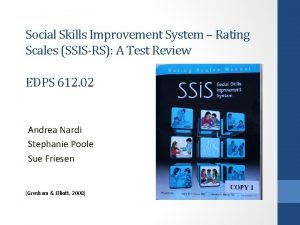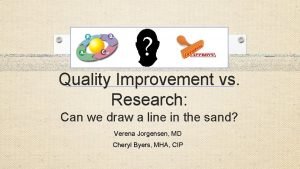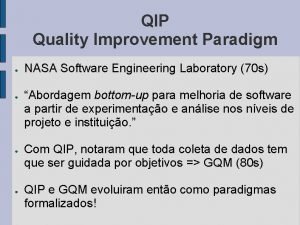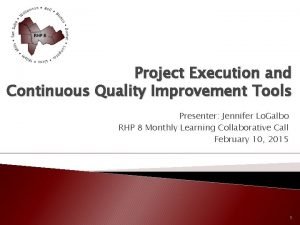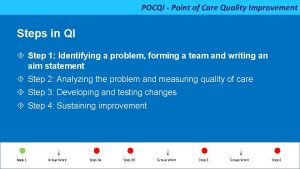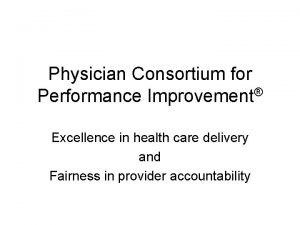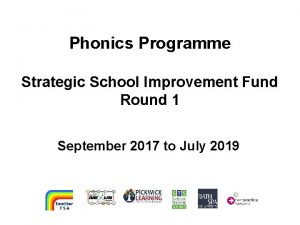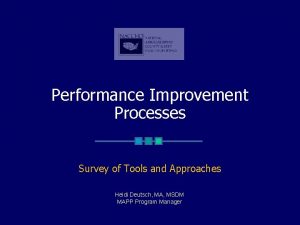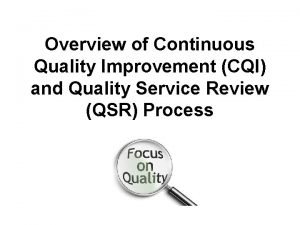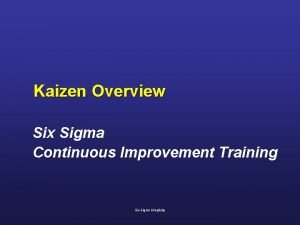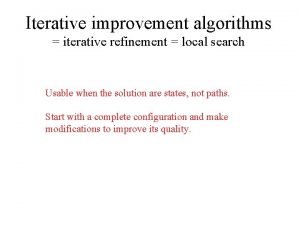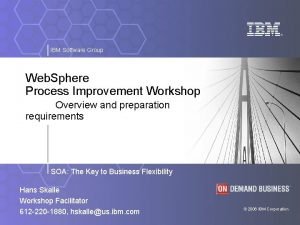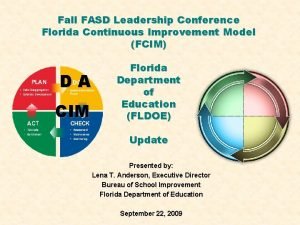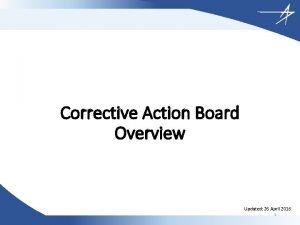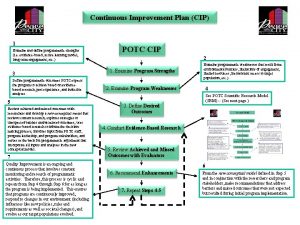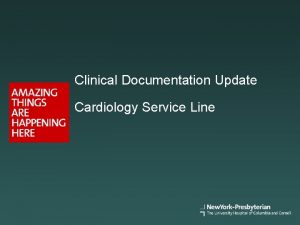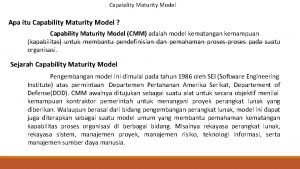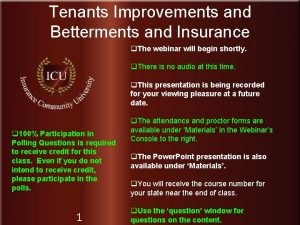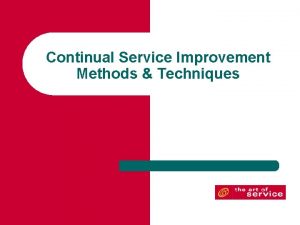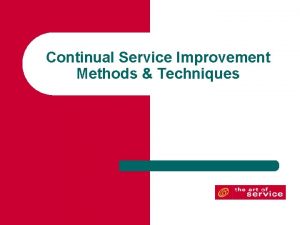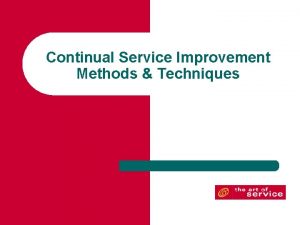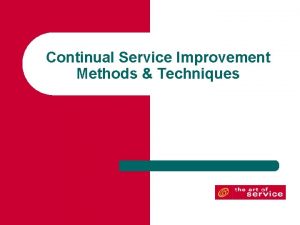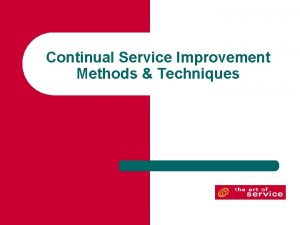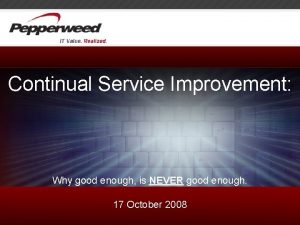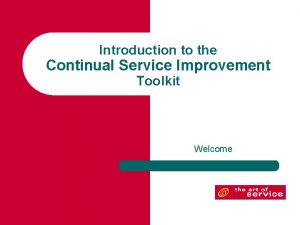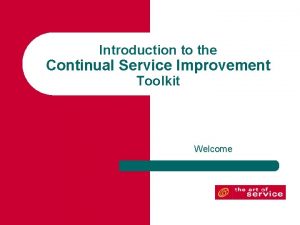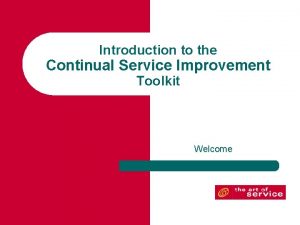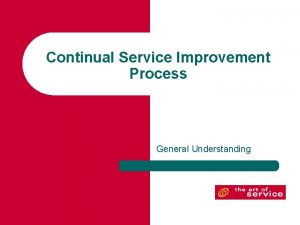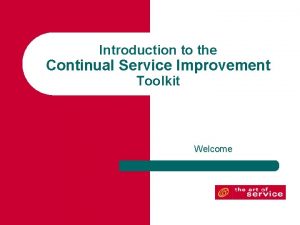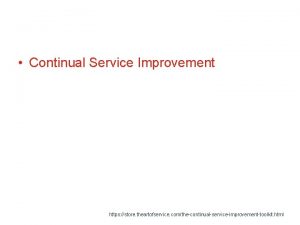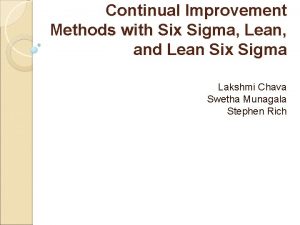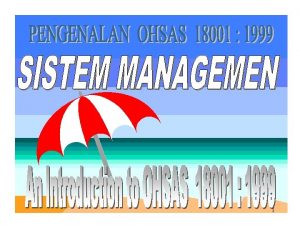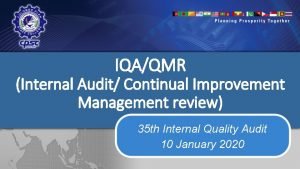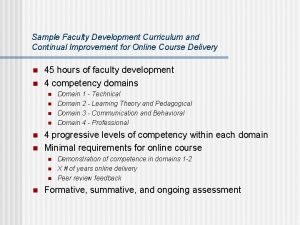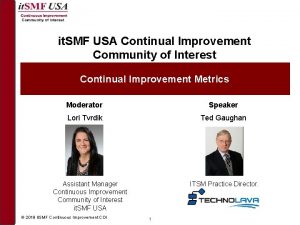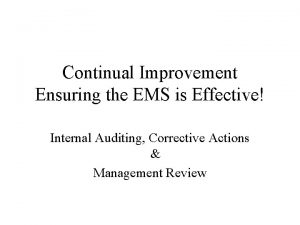Continual Service Improvement Methods Techniques Methods Techniques An










































































- Slides: 74

Continual Service Improvement Methods & Techniques

Methods & Techniques An effective choice of methods and techniques for the analysis, presentation and use of the measurement information is highly dependent on the particular circumstances in which these tasks are performed and can generally not be documented in advance. A goal-oriented attitude and professional expertise and education of the individuals are required.

Service Improvement Program (SIP) SLM should coordinate with Problem and Availability Management to instigate a SIP to identify and implement necessary actions to restore service quality. SIPs can also identify initiatives including: User awareness and training programs system testing improved documentation standards

Service Improvement Plans (SIP) Service Improvement Plans are formal plans to implement improvements to a process or service. The identified improvements may come from: • Breaches of Service Level Agreements. • Identification of user training and documentation issues. • Weak system testing. • Identified weak areas within internal and external support groups. • Audits.

CSI Register The CSI Register is a decision-making tool allowing the service provider to track, prioritize, and manage multiple improvements to closure. The CSI Register is a list of open SIPs.

Continual Service Improvement Audits and Assessments

Internal Audits are a requirement for ISO/IEC 20000 certification. Internal Audits are periodic checks to determine: • External requirements are fulfilled. • Service management system requirements are fulfilled.

Assessments Formal mechanisms for comparing the operational process environment to the performance standards for the purpose of measuring improved process capability and/or identify potential shortcomings that could be addressed. The benefit of assessments is that they provide the opportunity to sample specific elements of a process which impacts the efficiency and effectiveness of the process.

When to assess Assessments can be conducted at any time. A way to think about assessment timing is in line with the improvement lifecycle: • Plan – Assess the targeted processes at the interception of process introduction to form the basis for a process improvement project. • Plan – A check during process implementation or improvement activities • serves as validation that process project objectives are being met and provide tangible evidence that benefits are being achieved from the investment of time, talent and resources to process initiatives. Do/Check – During conclusion of the process project, it is important to validate the maturation of the process though the efforts of the project team. In addition, scheduling periodic reassessments can support the overall organization integration and quality efforts.

What to assess and how The assessment’s scope is one of the key decisions. Scope should be based on the assessments' objective and the expected future use of process assessments and assessment reports. There are 3 potential scope levels: • Process only. • People, process and technology. • Full assessment. All these factors are compared to the maturity attributes of the selected maturity model.

Advantages & Disadvantages Advantages: • Provide objective perspective. • Compare to standard maturity model and process framework. • Accurate determination of process gaps. • Recommend actions and plan solutions. • Repeatable process. Disadvantages: • Only provides a snapshot. • Does not reflect current business or cultural dynamics and process operational issues. • If the assessment process is outsourced can be vendor or framework dependent. • If this is the case, it is difficult to compare to industry standards. • Subject to the opinion of assessors.

© Crown Copyright 2013 Reproduced under licence from AXELOS Value of processes vs. maturity of processes

© Crown Copyright 2013 Reproduced under licence from AXELOS Gap Analysis Example: Service Gap Model

Continual Service Improvement Benchmarking

Benchmarking is a process used in management, particularly strategic management, in which organizations evaluate various aspects of their processes in relation to best practices, usually within their own sector. This allows organizations to develop plans on how to adopt such best practice, usually with the aim of increasing some aspect of performance.

Challenge Benchmarking may be a one-time event, but is often treated as a continual process in which organizations continually seek to challenge their practices.

Benchmarking - as a Lever Benchmarking is sometimes the only way to persuade organization in to adopting new methods and tools that improve their effectiveness and efficiency. Presenting the facts with the support of proven "best practice" can combat resistance to change. “We don’t need to change, we’ve always done it this way and its worked fine most of the time”

Benchmarking - Steering Instrument Benchmarking is a management technique to improve performance. It provides an ongoing method of measuring and improving products, services and practices against the best that can be found in any industry anywhere. It has been defined as "the search for industry best practices which lead to superior performance. "

Benchmarking categories Benchmarking is a great tool for identifying improvement areas and evaluating improvement implementation activities. Organizations can conduct internal or external benchmark studies. Improving service management can be as simple as: "Are we better today than we were yesterday? " These are incremental improvements.

Baselines A benchmark used as a reference point for later comparison. Examples 1. An ITSCM Baseline can be used a starting point to measure the effect of a Service Improvement Plan. 2. A performance Baseline can be used to measure changes in performance over the lifetime of an IT service. 3. A Configuration Management baseline can be used to enable the IT infrastructure to be restored to a known configuration if a change or release fails.

Benchmarking - Value Benchmarking is the basis for: • Profiling quality in the market. • Boosting self-confidence and pride in employees as well as motivating and tying employees to an organization. • Trust from customers that the organization is a good IT service management provider.

Benchmarking - Benefits Benchmarking reveals quick wins: opportunities for improvement that are easy and cheap to implement, but that will provide substantial benefit, e. g. within process effectiveness, reduced costs, staff resourcing. When benchmarking is used successfully, the costs of change will be more than repaid through the improvements implemented.

Benchmarking procedure Identify problem areas. Because benchmarking can be applied to any business process or function, a range of research techniques may be required. They include: • • • Informal conversations with customers, employees, or suppliers. Focus groups. In-depth marketing research. Quantitative research. Surveys. Questionnaires. Process mapping. Financial ratio analysis. Quality control variance reports.

Benchmarking costs Benchmarking is a moderately expensive process, but most organizations find that it more than pays for itself. The 3 main types of costs are: • Visit costs. • Time costs. • Benchmarking database costs.

Who’s involved? Within an organization there will be 3 parties involved in benchmarking: • The customer. • The user or consumer. • The internal service provider. There will also be participation from external parties: • External service providers. • Members of the public. • Benchmarking partners.

Continual Service Improvement Service Measurement

Service Measurement – Value to business Responsible for defining how to measure IT Service Management and IT Service improvements. Coordinate the data collection for measurements from the other processes and functions. There are four main reasons to monitor and measure: 1. To validate. 2. To direct. 3. To justify. 4. To intervene.

Scale of measurement In general, a metric is a scale of measurement defined in terms of a standard, i. e. in terms of a well-defined unit. The quantification of an event through the process of measurement relies on the existence of an explicit or implicit metric, which is the standard to which measurements are referenced.

Business Models Metrics used in several business models, including CMMI, are used. These measurements or metrics can be used to track trends, productivity, resources and much more. Typically, the metrics tracked are KPIs.

How many CSFs and KPIs? It is recommended that in the early stages of a project only two or three KPIs for each CSF are defined, monitored, and reported on. As the maturity of a service and service management processes increase, additional KPIs can be added. Based on what is important to the business and IT management the KPIs may change over a period of time. In addition, as service management processes are implemented this will often change the KPIs of other processes.

Using organizational metrics To be effective, measurements and metrics should be woven through the complete organization, touching the strategic as well as the tactical level. To successfully support the key business drivers, the IT Service Manager needs to know what and how well each part of the organization contributes to the final success.

Service Measurement It is no longer sufficient to measure and report against the performance of an individual component such as a server or application. IT must now be able to measure and report against end-to-end service. There are 3 basic measurements that most IT organizations utilize: • Availability of the service. • Reliability of the service. • Performance of the service.

Measuring at component level Measuring at the component level is necessary and valuable, but service measurement must go further than the component level. Service measurement will require someone to take the individual measurements and combine them to provide a view of the true customer experience.

Developing a Service Measurement Framework A challenge many organizations face is the creation of a Service Measurement Framework that leads to value added reporting. It can prove difficult at first but the result over time prove that it is worth the effort. Keep in mind that service measurement is not the end result, in itself. The end result should be to improve services and also improve accountability.

Critical elements of Service Measurement Frameworks For a successful Service Measurement Framework the following critical elements are required: • • • Integrated into business planning. Focused on business and IT goals and objectives. Cost-effective. Balanced in its approach on what is measured. Able to withstand change.

Continual Service Improvement Metrics

Types of Metrics There are 3 types of metrics that an organization will need to collect to support CSI activities as well as other process activities: • Technology Metrics. • Process Metrics. • Service Metrics.

Tension Metrics The job from any support team is a balancing act of three elements: • Resources – people and money. • Features - the product or service and its quality. • The schedule.

Next step The next step is to identify the metrics and measurements required to compute the KPI. There are two basic types of KPI: • Qualitative. • Quantitative.

KPIs An important aspect to consider is whether a KPI is fit for use. Key questions could be: • What does the KPI really tell us about goal achievement? • If we fail to meet the KPI, does it mean we have failing to meet our goals? • How easy is the KPI to interpret? Does it help us decide on a course of action? • When do we need the information? How often? How will it be made available? • To what extent is the KPI stable and accurate? • How easy is it to change the KPI? • How can we measure the KPI now?

Goals and Metrics Each phase of the service lifecycle requires very specific contributions from the key roles identified in Service Design, Service Transition and Service Operation, each of which has very specific goals to meet. Ultimately, the quality of the service will be determined by how well each role meets its goals, and how well those sometimes conflicting goals are managed along the way. Therefore, it is essential that the organization finds a way to measure performance – by applying a set of metrics to every goal.

Service Quality Metrics Organizational or process metrics can be further broken down into product quality metrics and process quality metrics. Product quality metrics are the metrics that support the contribution to the delivery of quality products. Process quality metrics are the quality metrics related to efficient and effective process management.

Continual Service Improvement Scorecards and Reporting

Balanced Scorecard Recognizing some of the weaknesses and vagueness of previous management approaches, the balanced scorecard approach provides a clear prescription as to what companies should measure in order to "balance" the financial perspective.

Reporting Once the SLA is agreed and monitoring begins, focus must be given to producing Service Achievement Reports. Periodic reporting should include: • Details of performance against SLA targets. • Trends in Service Levels. • Specific Actions being undertaken to improve service quality. • Internal IT performance reviews and Supplier reviews. • Any changes that need to be made to documentation.

Creating Reports The most essential starting point when creating reports is to know: • • • Who is the target audience of the report? What will the report be used for? Who is responsible for creating the report? How will the report be created? How frequently is the report to be created? What information will be produced, shared or exchanged?

Reports can be set up to show: • Results for a service – supporting reports would be the individual measurements on components. • Health of a service management process – this report will have certain process KPI results. • Functional reports – such as telephony reports for the Service Desk.

Continual Service Improvement Return on Investment

Return On Investment (ROI) ROI is a concept for quantifying the value of an investment. Its use and meaning are not always precise. When dealing with financial offers, ROI most likely means Return on Invested Capital (ROIC), a measure of business performance. This is not the case with service management, ROI is used as a measure of the ability to use assets to generate additional value.

Keep it simple In the simplest sense, it is the net profile of an investment divided by the net worth of the assets invested. The resulting % is applied to either additional top-line revenue or the elimination of bottomline cost.

Tactical Benefits While a service can be directly linked and justified through specific business imperatives, few companies can readily identify the financial return for the specific aspects of service management. It is often an investment that companies must make in advance of any return.

Business Case A decision support and planning tool that projects the likely consequences of a business action. The consequences can take on qualitative and quantitative dimensions. A financial analysis, for example, is frequently central to a good business case.

Business Objectives The structure of a Business Case varies from organization to organization. What they all have in common is a detailed set of business impact or benefits. Business impact is in turn linked to business objectives. A business objective is the reason for considering a service management initiative in the first place.

Business Impact While most of the Business Case argument relies on cost analysis, there is much more a service management initiative than financials. The scope of possible non-financial business impacts is summarized as: A business impact has no value unless it is linked to a business objective. There does not have to be a one-to-one relationship between business impact and business objective.

Pre-program ROI The term capital budgeting is used to describe how managers plan significant outlays on projects that have long-term implications. A service management initiative may sometimes require capital budgeting.

Capital budgeting Capital Budgeting is the commitment of funds now in order to receive a return in the future in the form of additional cash inflows or reduced cost outflows. Capital budgeting decisions fall into two broad categories: • Screening Decisions. • Preference Decisions.

Screening Decisions (NPV) An investment typically occurs early while returns do not occur until some time later. Therefore, the time value of money, or discounted cash flows, should be accounted for. There are two approaches to making capital budgeting decisions using discounted cash flows: • Net Present Value (NPV). • Internal Rate of Return (IRR).

What is an organization’s discount rate? A companies cost of capital is typically considered the minimum required rate of return. This is the average rate of return the company must pay to its long-term shareholders or creditors for use of their funds. Therefore, the cost of capital serves as a minimum screening device.

Other methods There are other methods for making capital budgeting decisions, for example: • Pay-back. • Simple Rate of Return. However, Pay-back is not a true measure of the profitability of an investment and Simple Rate of Return does not consider the time value of money.

Intangible benefits Process improvement and automation are common examples of difficult-to-estimate cash flows. The up-front tangible costs are easy to estimate. The intangible benefits, such as lessened risk, greater reliability, quality and speed are much more difficult to estimate. They are very real in impact but still challenging in cash flows.

Preference Decisions (IRR) There are often many opportunities that pass the screening process. The bad news is not all can be acted on. Financial or resource constraints may preclude investing in every opportunity. Preference decisions, sometimes called rationing or ranking decisions, must be made. The competing alternatives are ranked.

Post-program ROI Without proof of value, executives may cease further investment. Therefore, if a service management initiative is initiated with prior ROI analysis, it is recommended that analysis be conducted at an appropriate time after. Program objectives should be clear as they serve to guide the depth and scope of the ROI analysis.

Data to monetary conversion To calculate ROI, it is essential to convert the impact data to monetary values. Only then can those values be compared to program costs. The challenge is in assigning a value to each unit of data. The technique applied will vary and will often depend on the nature of the data: A quality measure is assigned or calculated and reported as a standard value. Staff reductions or efficiency improvements are reported as a standard value. Improvements in business performance are reported as a standard value. Internal and external experts are used to established the value of a measure.

Determine program costs This requires tracking all the related costs of the ITIL program. It can include: • The planning, design and implementation costs. These are pro-rated over the expected life of the program. • The technology acquisition costs. • The education expenses.

Continual Service Improvement Reviews

Reviews • Service • Management • Project • Lessons Learned • Implementation

Reviewing and Evaluating Periodic review meetings must be held on a regular basis with: § Customers to review service achievements and to preview any issues for the coming period. § Internal IT groups and Suppliers to review OLAs and Ucs. Actions for responding to SLA breaches or identified weak areas should be minuted and reviewed at the next meeting to ensure that action items are being followed up and properly implemented.

Effort Cost CSI improvement activities can require a considerable amount of effort and money for larger-scale improvement projects versus minimal time and effort for some more incremental improvements. It is up to the business and IT to decide if the costs and effort is worth it. Costs associated with implementing and operating a measurement framework would include: • • Labor costs. Tooling costs. Training costs. Expertise costs.

Implementation review and evaluation is key to determining the effectiveness of a CSI improvement program. Some common areas for review include: • • Did we correctly assess the current situation and define the problem statement? Did we commit to the right goals? Did we make the right decisions when developing the strategy for improving IT services? Did we implement the strategy correctly? Have we improved the IT service provision? What lessons did we learn, where are we now?

Continual Service Improvement Summary

Challenges Each organization will have its own challenges, as with initiating any type of change one of the major challenges will be managing the behavioral changes that are required. In addition, CSI will require adequate tools for managing the data, resources will need to be allocated and understand their roles and responsibilities as well as having the correct skills to execute the CSI activities.

CSFs • • • Appointment of a CSI Manager. Adoption of CSI within the organization. Management commitment. Defining clear criteria for prioritizing improvement projects. Adoption of the service lifecycle approach. Sufficient and ongoing funding for CSI activities. Resource allocation. Technology to support the CSI activities. Adoption of processes.

Risks • • • Being over ambitious and unrealistic. Not discussing improvement opportunities with the business. Not focusing on improving both services and service management processes. Not prioritizing improvement projects. Implementing CSI with little or no technology. Implementing a CSI initiative with no resources. Implementing CSI without knowledge transfer and training. Not performing all steps of the 7 Step Improvement Process. Lack of management taking action. Lack of communication/ awareness campaign. Removing testing (or only partially testing) before implementation.

Summary • Implementing CSI is a challenge, it requires a change in management and staff attitudes and values to ensure that all parties recognize CSI needs to be proactive and not reactive. • It is critical to identifying risks and challenges before implementing CSI. • Knowing the CSFs before undertaking the implementation of CSI helps to manage the risks and challenges. • One step at a time…
 Itil 7 step continuous improvement process
Itil 7 step continuous improvement process Continual service improvement metrics
Continual service improvement metrics Help desk improvement plan
Help desk improvement plan Continual
Continual Soil improvement methods
Soil improvement methods Reliability improvement techniques
Reliability improvement techniques The allied health profession service improvement project
The allied health profession service improvement project The allied health profession service improvement project
The allied health profession service improvement project It consolidation strategy
It consolidation strategy Direct wax pattern
Direct wax pattern Food and beverage service sequence
Food and beverage service sequence Monitoring customer service
Monitoring customer service Fonctions et solutions techniques
Fonctions et solutions techniques Environmentally safe refrigerant service tips & techniques
Environmentally safe refrigerant service tips & techniques Temperature glide
Temperature glide Techniques for achieving good quality of service
Techniques for achieving good quality of service Itil service lifecycle model
Itil service lifecycle model Itil service management lifecycle
Itil service management lifecycle Desired service and adequate service example
Desired service and adequate service example Service provider and service consumer
Service provider and service consumer Mpls class of service
Mpls class of service New service development in service marketing
New service development in service marketing Service owner vs service manager
Service owner vs service manager Adp self service help
Adp self service help Work improvement team
Work improvement team Trial and improvement examples
Trial and improvement examples Four improvement strategies in tqm
Four improvement strategies in tqm Together towards improvement
Together towards improvement Promoting moral improvement
Promoting moral improvement Fha title i home improvement loan
Fha title i home improvement loan Performance improvement plan examples
Performance improvement plan examples Jrotc continuous improvement plan
Jrotc continuous improvement plan Identify priority improvement areas
Identify priority improvement areas Social skills improvement system sample report
Social skills improvement system sample report Shaala siddhi school evaluation dashboard
Shaala siddhi school evaluation dashboard School improvement plan sample deped
School improvement plan sample deped Quality improvement vs research
Quality improvement vs research Qsen phases
Qsen phases Quality improvement paradigm
Quality improvement paradigm Continuous improvement
Continuous improvement Define continuous quality improvement
Define continuous quality improvement Pocqi ppt
Pocqi ppt Physician consortium for performance improvement
Physician consortium for performance improvement Strategic school improvement fund round 3
Strategic school improvement fund round 3 Performance improvement survey
Performance improvement survey Define continuous quality improvement
Define continuous quality improvement Aimsweb benchmark scores and percentiles
Aimsweb benchmark scores and percentiles Outpatient clinical documentation improvement
Outpatient clinical documentation improvement Ohio state health assessment
Ohio state health assessment Ana model of quality assurance
Ana model of quality assurance Nsla
Nsla If you can not measure it you can not improve it
If you can not measure it you can not improve it Pam document for hod
Pam document for hod Managing for daily improvement
Managing for daily improvement 1 improvement per day
1 improvement per day Search by image
Search by image Rapid improvement model
Rapid improvement model Attendance improvement strategies
Attendance improvement strategies Improving software economics in project management
Improving software economics in project management Illinois crop improvement association
Illinois crop improvement association Ibm checkpoint goals examples
Ibm checkpoint goals examples Florida continuous improvement model
Florida continuous improvement model Leasehold improvement
Leasehold improvement Efmd quality improvement system
Efmd quality improvement system Corrective action board
Corrective action board Cip 1
Cip 1 Quality improvement vs quality assurance
Quality improvement vs quality assurance Clinical documentation improvement for cardiology
Clinical documentation improvement for cardiology Iterative improvement algorithm example
Iterative improvement algorithm example Contoh capability maturity model
Contoh capability maturity model Biotechnology in crop improvement
Biotechnology in crop improvement Altran nord
Altran nord Work improvement in small enterprises
Work improvement in small enterprises Entrepreneurship sae examples
Entrepreneurship sae examples Tenant improvement and betterments
Tenant improvement and betterments

